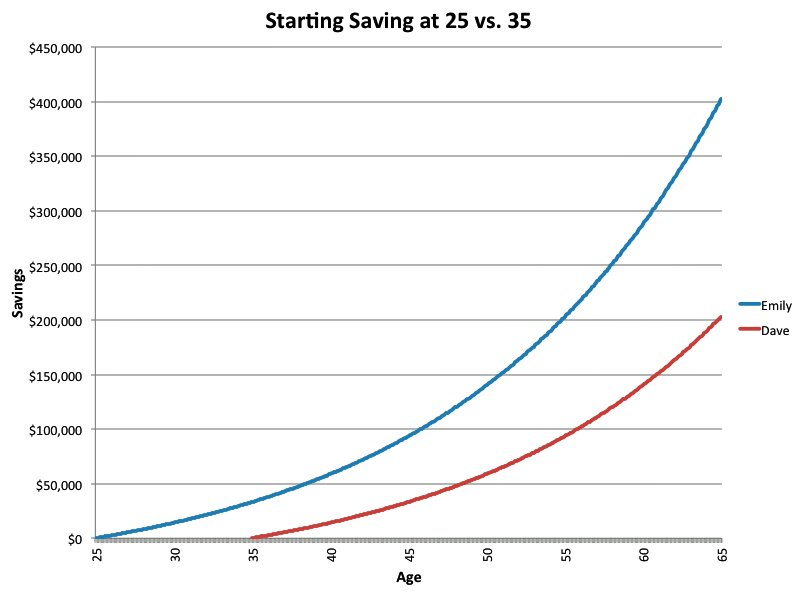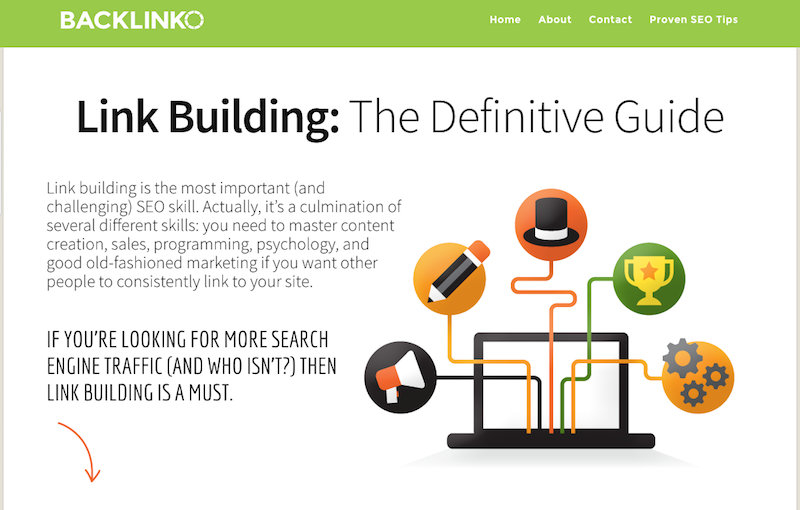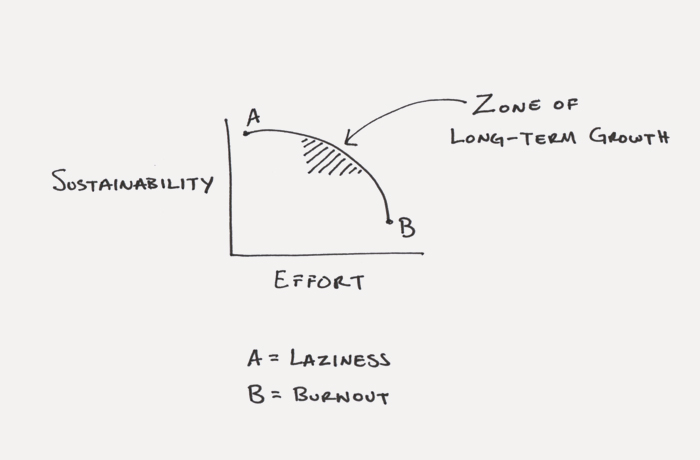Or, Unsexy Strategies for Long-Term Growth.
If you want to retire early, there are two important rules you should follow.
The first is that time in the market is far more important than timing the market. That means that investing early and giving your money as much time as possible to grow and compound is a better strategy than trying to pick the next hot stocks.
Even Warren Buffet, one of the most successful investors in history, says, "The biggest mistake is not learning the habits of saving properly early. It's pretty easy to get well-to-do slowly."
People who retire early are the ones who start investing a chunk of each paycheck in a retirement account in their 20s. (This data from Capitalize suggests 10-15% of your monthly income.) Sure, you might strike gold some other way, but the best strategy is the least sexy: Just set aside a percentage of your income, and then let the market do its job.
Yes, this article really is about content marketing. Stay with me for a minute.
In this example from Business Insider, hypothetical investors Emily and Dave each invest $200 per month. Emily starts at age 25 but Dave waits until age 35. By the time they are 65, Emily has invested $24,000 more, but because she started earlier, she ends up with $199,374 more.

In short, you should commit to getting rich slowly. Starting early is important, but there's another key element to securing big wins.
Learning to Think Big
Ramit Sethi does a great job explaining the second rule of investing in his book I Will Teach You To Be Rich: People who retire early focus on big wins.
Instead of skipping the morning latte — that's a small win — Ramit recommends automating a percentage of monthly income to a retirement fund; paying off debt to avoid excessive interest; negotiating ruthlessly on big purchases, such as a home or a car; and finding ways to earn more money.
If you had to choose between using your limited willpower to cut back on something you love that costs $2 a day and learning to negotiate a $10,000 salary increase, which would you rather do?
You can read way more about big wins on Sethi’s blog, but you get the idea: Find fundamental ways to make massive long-term gains instead of sweating all the details.
Together, these two rules make up the Big Win Principle. And now that you know it, you can apply it to all kinds of things, including content marketing.
To recap ...
- Start early.
- Get the fundamentals right.
OK, now to apply this thinking to content marketing.
The earlier you start with content marketing — assuming you nail a few fundamentals — the greater your returns. In the same way compounding interest nets exponential growth, content can live a long, healthy life.
This post is about execution. If you've already decided that building an audience is part of your growth strategy — keep in mind that companies such as Slack, Apple and Uber did not choose this route, so there are other ways — I'm going to show you a few things you should do to maximize your returns. These are the big wins you must get right in order to grow.
These are not shortcuts. They are just the things that are often taken for granted, resulting in tons of missed readers over the lifetime of your blog. So stop fussing over the little things, and start getting serious about your investment.
1. Define a Target Audience
Skip this step and risk years of writing for no one.
That sounds harsh, but it's true. You must decide whom you are writing for, and the key is to get very narrow. For example, this blog is targeted at content marketers who work independently or for SaaS companies. I write for these people because I am one of them. Choosing a narrow audience means I can deliver value to a small group. Raving fans spread the word and, slowly, the audience grows. I'm not limited to this group, but I serve them first as a means to gain traction. Going deep first makes it easier to go wide later.
In a recent podcast, The 4-Hour Work Week author Tim Ferriss explained how he used this strategy to land his first book on the New York Times’ best-seller list:
The target market is not the total market. The target market is the tip of the spear. That is what you use at the front lines to win the battle that allows you to win the war. And you win the war when your target demographic expands to include a lot of other people.
Ferriss focused on 20- to 35-year-old tech-savvy men living in New York City and San Francisco. If you've read Ferriss’ book, you understand how this group could derive enormous value from it. They are young, have money, think big and have skills that allow them to work anywhere. By maxing out this market, the book received rave reviews, which later helped multiply its success in other demographics.
Most people write for their peers, clients or employer, not their core audience. That may be a way to keep your job, but it will limit your ability to grow an audience. And an audience is more valuable than any single client or employer.
One of the hardest things in journalism is to write for your readers rather than your peers or editors.
— Ezra Klein (@ezraklein) July 11, 2015Let's look at a hypothetical example. If you were hired to do content at Dropbox, it would be easy to say, "Anyone can use Dropbox, so we're targeting everyone." That will never, ever work. Instead, start with people who have pain points that can be solved by the product. Designers are a perfect market, since they often need to share large files, collect feedback, make revisions and share again. In this case, writing content specifically for designers is a great starting point. As the content gains traction, others will see the obvious benefits of the product, allowing you to expand your reach.
In his post 1,000 True Fans, Wired founder Kevin Kelly explains that creating a handful of raving fans is actually the best way to appeal to a mass audience:
This small circle of diehard fans, which can provide you with a living, is surrounded by concentric circles of Lesser Fans. These folks will not purchase everything you do, and may not seek out direct contact, but they will buy much of what you produce. The processes you develop to feed your True Fans will also nurture Lesser Fans. As you acquire new True Fans, you can also add many more Lesser Fans. If you keep going, you may indeed end up with millions of fans and reach a hit. I don’t know of any creator who is not interested in having a million fans.

Defining your audience now sets you up for big wins later. Skipping this important step means you'll waste time writing posts for different audiences, watering down your content overall and likely ruining any chance for exponential growth.
| More reading on this topic |
|---|
| How to Build a Large Audience From Scratch (Tim Ferriss) |
| 1,000 True Fans (Kevin Kelly) |
| How to Find Your Target Audience (Kristi Hines) |
2. Create a Real Keyword Strategy
When people hire me to write for them, I always ask about their keyword strategy. If they have a real keyword strategy — you'll learn what "real" means in a minute — I can make sure their investment is worth it. I once wrote for a site that had 300 target keywords and published three short posts per week. As you might imagine, the site gained traction for exactly zero keywords, because the content was all over the place. That's not to say it wasn't interesting or useful — just that SEO as a traffic source was being ignored.
Almost no one has a real keyword strategy, but there is an easy way to fix that. It's easiest to explain by looking at a real example.
Brian Dean, the brains behind Backlinko, is a one-man show in a very competitive space. He ranks really well for a number of valuable SEO-related keywords by going deep instead of wide.
Brian chooses a handful of keywords that he can maximize, and that helps him rank for all kinds of long-tail variations. Instead of dripping out lots of short posts on the topics for which he wants to rank, he creates massive resources designed to rank specifically for a single keyword. His blog has just 21 posts, but it gets more than 100,000 visitors each month. Targeting more than two or three keywords is insane unless you have a team of writers. It's like Dropbox targeting everyone with a computer: It is slow and inefficient and is a surefire way to spend years instead of months growing a site.
Here's a look at how Brian got his blog ranked alongside Wikipedia for the term "link building." (See the post here.)

The difference between this post and the 377,000,000 (seriously) other posts that cover link building is that Brian went all-in. He created a guide that covers the topic from A to Z, and he hired a designer to make it look great. As a result, he ranks very high for the target term, as well as for hundreds of long-tail variations.
This is a technique called siloing. It's explained in great detail on the Bruce Clay blog, but here's the most important sentence: "More often than not, a website is a disjointed array of unrelated information with no clear central theme."
I really encourage you to read the full post, as it lays out the strategy for choosing keywords and dives into things such as site architecture.
But, in short, you need to move away from this:

And toward this:

Image credit: BruceClay.com
Choosing the right keywords goes hand in hand with defining your target audience. Most content marketers have no business trying to rank for more than a handful of keywords. I recommend choosing two or three and going as deep as possible. Remember what Tim Ferriss said about defining your audience: "The target market isn't the total market."
3. Commit to a Realistic Publishing Schedule
Do you have competitors bigger than yourself? The answer is almost definitely yes. How do you expect to compete with them if they have more resources than you do? The answer is force multipliers.
In case you aren't familiar with the term, here's an explanation from Changing Minds author David Straker:
The basic principle of force multiplication is to find and use factors that increase the effective power that you have (or reduce that of your opponents). Using multiple multipliers has an even greater effect, such that a well-multiplied small force can successfully take on a much larger force.
Force multipliers sound awesome, right? They are. They also sound sexy — a silver bullet that can solve all of your problems. That just isn't the case, though. (Remember, this post is all about unsexy strategies for long-term growth.)
A regular publishing schedule is actually a force multiplier that dramatically increases your chances for success with content marketing. Others force multipliers include hiring great writers, instilling a mindset of success, and the two steps mentioned above.
The hardest part about a force multiplier such as a schedule is the commitment. My advice is to start with a constraint, and then hold yourself accountable by making it public.
Contrary to popular belief, constraints actually help you access your inner creativity and perform at your best. Without constraints such as due dates and word counts, most writers would nitpick their own work until they give up on publishing it at all.
If you expect content to fuel growth, you must commit to a publishing schedule. It's a constraint that has helped some of the world's best blogs achieve that top status.
Here's writer James Clear on the topic:
I want to be a better writer, so I set a schedule where I have to publish a new article every Monday and Thursday. The schedule is my constraint. It doesn’t matter how good or how bad the article is. It doesn’t matter how long or how short it is. I have to get something out every Monday and Thursday. This forces me to be creative and to do the one thing that good writers do: write. I don’t always hit the mark, but I have stuck with this schedule for two years and I’ve written over 200,000 words.
Think of your publishing schedule like a new exercise plan. If you never work out and then commit to immediately start running five days per week, you are sure to fail. But if you slowly incorporate running into your life, you'll feel great about your progress and be more likely to continue. The point is that the best exercise plan is the one you actually follow, not the “perfect” plan that you can't maintain.
The same is true of your publishing schedule. You have to choose a frequency that is sustainable, even if it means starting slowly.
Here is more insight from the great James Clear (whose blog is truly a must-read):
In many areas of life, there is a magical zone of long-term growth: Pushing enough to make progress, but not so much that it is unsustainable.
Commit to something you can sustain, and change it only when you're hungry for more. If publishing new content once per month is all you can manage, make it the best damn thing your audience will read all month. As you grow, you can hire another writer to help, or you can offload other responsibilities, so you can spend more time writing.
It's just like the investing example we talked about before. Emily — the investor who started early and saved $200,000 more than Dave — committed and never looked back. She didn't wait until she could contribute $500 per month to her retirement; she took the $200 she could afford and started saving.
Have questions or thoughts on this? Hit me up on Twitter.
S/O to David Ly Khim for designing to slide deck.


